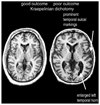Very poor outcome schizophrenia: clinical and neuroimaging aspects
- PMID: 17671868
- PMCID: PMC2709451
- DOI: 10.1080/09540260701486563
Very poor outcome schizophrenia: clinical and neuroimaging aspects
Abstract
In spite of significant advances in treatment of patients with schizophrenia and continued efforts towards their deinstitutionalization, a considerable group of patients remain chronically hospitalized or otherwise dependent on others for basic necessities of life. It has been proposed that these patients belong to a distinct etiopathological subgroup, termed Kraepelinian, whose course of illness may be progressive and resistant to treatment. Indeed, longitudinal studies appear to show that elderly Kraepelinian patients follow a course of rapid cognitive and functional deterioration, commensurate with a dementing process, and that their poor functional status is closely correlated with the cognitive deterioration. Recent neuroimaging studies described a pattern of posteriorization of grey and white matter deficits with poor outcome in schizophrenia, and produced a constellation of findings implicating primary processing of visual and auditory information as central to the impaired functional status in this patient group. These studies are summarized in detail in this review and future directions for neuroimaging assessment of very poor outcome patients with schizophrenia are suggested.
Figures


References
-
- Albus M, Hubmann W, Ehrenberg C, Forcht U, Mohr F, Sobizack N, et al. Neuropsychological impairment in first-episode and chronic schizophrenic patients. European Archives of Psychiatry Clinical Neurosciences. 1996;246:249–255. - PubMed
-
- Arnold SE, Gur RE, Shapiro RM, Fisher KR, Moberg PJ, Gibney MR, et al. Prospective clinicopathologic studies of schizophrenia: Accrual and assessment of patients. American Journal of Psychiatry. 1995a;152:731–737. - PubMed
-
- Arnold SE, Franz BR, Trojanowski JQ, Moberg PJ, Gur RE. Glial fibrillary protein-immunoreactive astrocytosis in elderly patients with schizophrenia and dementia. Acta Neuropathologica. 1995b;91:269–277. - PubMed
-
- Arnold SE, Trojanowski JQ. Cognitive impairment in elderly schizophrenia: A dementia (still) lacking distinctive histopathology. Schizophrenia Bulletin. 1996;22:5–9. - PubMed
Publication types
MeSH terms
Grants and funding
LinkOut - more resources
Full Text Sources
Medical
